|

Crepuscule d'Hiver
1908
Gustave Marissiaux
1872-1929
1 2 3
_______________________
Rubbish
Lidija Dimkovska
Translated from the Macedonian by Ljubica Arsovska and Peggy Reid
exquisite corpse
You collect stickers and shells with your children,
and stamps and postcards,
arrange them devotedly in drawers and boxes,
smiling as your wife calls out
“you’re only creating rubbish,”
not knowing that suddenly a day will come
or rather the night of
that day
when you will be staggering blindly in your underwear
down the wet iron fire-escape.
Tottering away from your home,
with hands as empty as a new-dug grave
and fists black from beating the flames,
you dive beyond the diameter of God’s will,
looking behind you, and they are not there, a distant cry and a profound silence.
(....)
You need to start again from the beginning, they tell you,
while you would know only how to start from the middle, how to change the old,
make it better, nicer, more loved.
But when the dead are no longer alive
nobody knows how to start from either the end or the beginning.
You know, you know very well, how life is turned into scraps of rubbish,
but not how these scraps of rubbish can be turned into life.
...(more)
_______________________
Janus Head
Volume 13, Issue 1
Special Issue: Feminist Phenomenology
Introduction: [pdf]
Concepts and Methods in Interdisciplinary
Feminist Phenomenology
Eva-Maria Simms and Beata Stawarska
This volume showcases some of the current developments in
interdisciplinary feminist phenomenology. The notion that phenomenology
belongs to the field of feminist concerns and benefits from an engagement
with other disciplines hinges on a progressive and broad understanding of
what phenomenology is. Phenomenology is feminist as long as it includes
questions related to gendered experience and sexual difference within its field
of study. Contrary to the conservative and narrow view of phenomenology
as being confined to the stance of a (presumably) sexless, individualistic
ego, gendered embodiment and sexual hierarchy do not fall out of the
pure transcendental domain into the contingent and the empirical; they
belong to the aspirations of phenomenology to describe concrete, lived
human experience in its richness and complexity
_______________________
Paintings In Proust (Vol. 1, Swann’s Way)
public domain review
Today marks 100 years since Marcel Proust published Du côté de chez Swann (Swann’s Way), the first volume of A la recherche du temps perdu, his masterwork written over a period of 13 years, 1909 to 1922, largely at night in the silence of a cork-lined room. Throughout the seven volume long searching tour through his memories – in his attempts to describe scenes and emotions, to help elucidate a point, sharpen an image, or as simply a subject in itself – Proust would time and again turn to the visual arts. Indeed, as Proust says in the novel, “It is only through art that we can escape from ourselves and know how another person sees a universe which is not the same as our own and whose landscapes would otherwise have remained as unknown as any there may be on the moon.” He mentions more than a hundred painters from the 14th through the 20th century making, as the artist Eric Karpeles points out, “one of the most profoundly visual works in Western literature.” As a celebration of the centennial we have put together a few highlights of Proust’s many mentions of artworks to be found in the first volume, Swann’s Way, in which the narrator recounts his experiences growing up, participating in society, falling in love, and learning about art. The translations are from C.K. Scott Moncrieff’s English translation (available here on project Gutenberg, in the public domain). We are indebted also to the excellent Paintings in Proust by Eric Karpeles, for helping us greatly in identifying the various mentions of artworks – a highly recommended book.
(....)

Mother Lacing Her Bodice beside a Cradle
Pieter de Hooch
1670
... suddenly it seemed to be drawn aside, and—just as in those interiors by Pieter de Hooch, where the subject is set back a long way through the narrow framework of a half-opened door—infinitely remote, in colour quite different, velvety with the radiance of some intervening light, the little phrase appeared, dancing, pastoral, interpolated, episodic, belonging to another world.
...(more)
_______________________
Melville’s Secrets
Caleb Crain
Steamboats Are Ruining Everything
originally published in Leviathan: A Journal of Melville Studies 14.3 (October 2012)
But here is a hazard. If we agree that a novel like Moby-Dick contains a meaningful secret without being certain what that secret is, we create a magician’s prop of great efficacy—a box with a false bottom. If, in the course of interpretation, someone sneaks an idea into the box, that idea can be revealed later as an important truth, supported by Melville’s authority. Much critical warfare about canonical authors is premised on this dishonest game, which is not an accurate way of determining either truth or significance.
_______________________
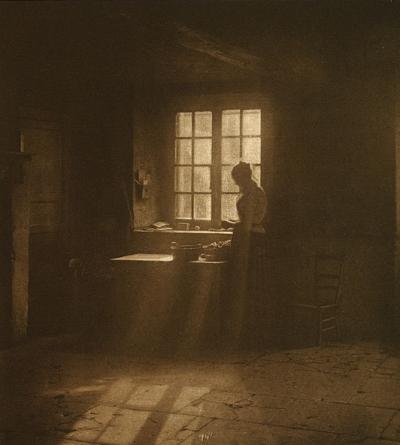
Gustave Marissiaux
_______________________
from The Unfollowing
Lyn Hejinian
lana turner
(....)
51
Afloat in a glass-bottom boat, I see into the sea—a miniscule emerald memento
That the strongest social bonds are forged by language doesn’t nullify
the power that dancing around the puppet effigies of the men
in power has
On the solemn face of the glinting belly is a button baby
You have to know how to roll on the horizon
Followers follow, possibles possibulate, coruscations consider, blood
coagulates
An allegory is a depiction of something that can’t be depicted
Mathias Madrid thrusts his fist toward his face in a mirror, Millicent
Malcolm pets a faithful falcon on a perch, Margaret Mason
makes fig jam to serve on cold toast with hard cheese
The pyrotechnical expanse, lacking azure, makes do with blatant
blackness, unspoken light
Winter’s cover’s curled back by adjectives—whacking winter’s roadside
cover
Stained owls and up over the ill rabbits they fly
Several hours go by but hours are impossible to perceive
I market, am marketed, mark, remark
We walk down a street under windows that let in noise that might
prompt someone asleep in the room to dream of drummers,
flautists, a man on stilts with a tuba, a sextet of giggling girls
What is it ghosts wonder? ...(more)
_______________________
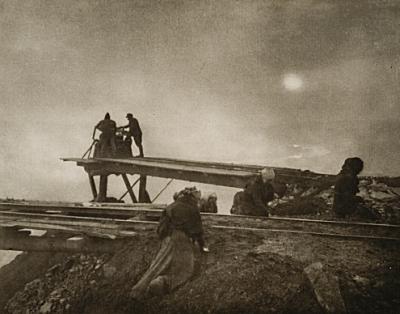
Le "Terril"
(The Slag Heap)
1905
Gustave Marissiaux
_______________________
Urban Futures?
noir-realism
The idea that cities have a future is almost quaint in this age of decline and fiscal bankruptcy, yet there are those who ‘keep the aspidistras flying’ - as that indefatigable commentator of the body social, George Orwell, in diaries, letters, essays, novels, stories, etc. so aptly coined that sense of keeping with a positive hope even in the midst of decay and ruin. For as my friend Arran James from attempts at living and synthetic zero puts it:
…as survivors, we shouldn’t be looking for ways to prevent the catastrophe but to mitigate it; we shouldn’t be looking for means of preventing the destruction but of building already from the ruins about us. The positing of the catastrophe into any kind of futurity is already a disavowal of the catastrophic real. Indeed, this might well be part of the development of a distinctly postnihilist ethics: like the survivors we are, shifting the terms of our thought from survival to rebuilding. Yet this rebuilding is not a question of a return to the pre-catastrophic world, and this is precisely where the importance of the post-apocalyptic comes into play.
...(more)
noir realism
exploring the edge worlds of neomaterialism
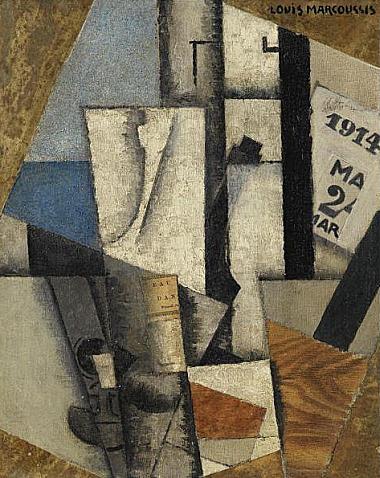
Nature Morte à L'Éphéméride
Louis Marcoussis
1914
_______________________
Learnig how to die in the Anthropocene
Roy Scranton
The New York Post-nihilist
arran james
-synthetic_zero
I’m not sure the objective nihilism of our age has been expressed in a more open fashion in the mainstream media before here. Scranton even concludes by calling for attention to turn to developing what those of us involved with the syntheticzero project are calling a post-nihilist praxis.
The biggest problem climate change poses isn’t how the Department of Defense should plan for resource wars, or how we should put up sea walls to protect Alphabet City, or when we should evacuate Hoboken. It won’t be addressed by buying a Prius, signing a treaty, or turning off the air-conditioning. The biggest problem we face is a philosophical one: understanding that this civilization is already dead. The sooner we confront this problem, and the sooner we realize there’s nothing we can do to save ourselves, the sooner we can get down to the hard work of adapting, with mortal humility, to our new reality.
(....) With a background in nursing, when I look at things from this perspective it’s all too clear that it’s far to late to stop the damage and that the damage is far too advanced for the possibility of a cure. I don’t want to stretch the metaphor beyond its effective use a heuristic device, but I have previously and continue to phrase the challenge to species as one of harm reduction and/or palliative care. If this sounds pessimistic or grim then go and re-read the article (if you haven’t already), and remember that the minimisation of harm is, at it’s most expansive, about attaining recovery. As far as I can see there is nothing about our grim reality that calls for a dire hopelessness. The call is, as always, to build the new world in the shell of the old.
...(more)
_______________________
from “I will build things anew”
Andy Frazee
[7]
I will build things anew (with firefly anatomy
pushpinned to a forest-for-the-trees [sieved
through neural net, partitioned by an isthmus
sky the sparrow-thought claims] its alphabetic
embrace a continuum of vacuum-tubed) canvas
stretched across a library globe, tan-skin tan
(the leather our embrace of pancreas, heart
wings [settle aside the symbol: come potentate,
sever the latitude-longitude, open the X to
ventricle (the ventricle to vessel [the vessel to
[8]
I will build things anew in the catastrophe
of sparrows, their headset eyes, headset wings
(the perhaps, an edit, a quarantine of debt,
a rhetoric of gain presupposing debt
[I is the inertia, the lift my father’s debt—
I will build things anew in the opening,
the parallel engine of gravity and snow
placematting the words (hello, halo, progeny
a catastrophe of nouns, a wren’s singularity
the compost bin a haven of reform in excelsis
...(more)
drunken boat 17
_______________________
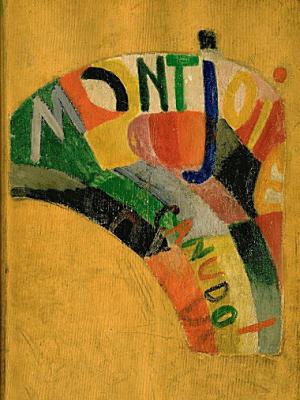
Montjoie
Sonia Delaunay
b. November 14, 1885
_______________________
The Coconut Milk
a play by John Ashbery
presented by John Latta
(....)
Scott
Hey! Don’t scream. I could radish you but these whiskers would kinda get in the way. Be careful of the Big Wig. And talk about a talking explosive—we’ve landed in the peach. Don’t asterisk him to nozzle before the lipstick comes off on the coconut ice cream tray. You know the ways these traitors stand in need of your five library books. The cautious desert rats. Temptation, girl, that’s in no way the sanitary process of defending a couple of inscrutable arms to be able to ask yourself these questions.
Rockshaw
You have heard of the coconut milk and
How it induces those who live near it.
Scott
There’s no use imagining things are always as wonderful as they are right now. They are always hammering. They are always hammering at us. ...(more)
_______________________

Sonia Delaunay
_______________________
The Miraculousness of the Commonplace
Remembering Arthur Danto
Morgan Meis
n+1
(....)
When art became philosophical in the late spring of 1964, it crossed an invisible line. With the Brillo Boxes, there is no clear demarcation between art and reality. If the Brillo Boxes can look just like Brillo boxes, and can still be art, then anything can be art. There is nothing inherent, nothing internal or necessary that makes something a work of art. Danto found this thought depressing at first. Art isn’t special anymore if it can be anything.
Later, Danto came to see the end of art as a great liberation. He began to think of that day in 1964 as the day “when perfect artistic freedom had become real.” The fact that art had ended meant that any artist could be “an abstractionist, a realist, an allegorist, a metaphysical painter, a surrealist, a landscapist, or a painter of still lifes or nudes. You could be a decorative artist, a literary artist, an anecdotalist, a religious painter, a pornographer. Everything was permitted, since nothing any longer was historically mandated.” Danto took to calling this new and permanent era after the end of art the “Post-Historical Period of Art.” It made him very happy.
I’m not sure the artists of the Post-Historical Period of Art are as happy about the end of art as Arthur Danto. Most of the artists I’ve known feel great anxiety facing the decision to make art with the knowledge that they can do and be anything. This kind of freedom can be immobilizing. I’m not sure that many artists fully grasp the link between the Hegelian moment when art became philosophical and the wide-open moment when art can be anything. Can’t we simply say that art became fragmented and diverse just as many other things became fragmented and diverse in the course of Modernity? Do we need to identify some Hegelian culmination of history in a moment of philosophical self-understanding in order to account for the fact that there are no firm boundaries between art and non-art anymore? Probably we don’t.
But Arthur Danto was writing and thinking himself out of a problem. He was having trouble accepting the art world as he found it. It might be said that he was having trouble accepting the world as he found it. The Brillo Boxes were Danto’s conversion moment. Danto wanted to be changed, to be transformed into a man who could see and understand the modern world around him. Danto’s eyes were open, but he felt he could not see. He needed to convert himself in order to live.
...(more)
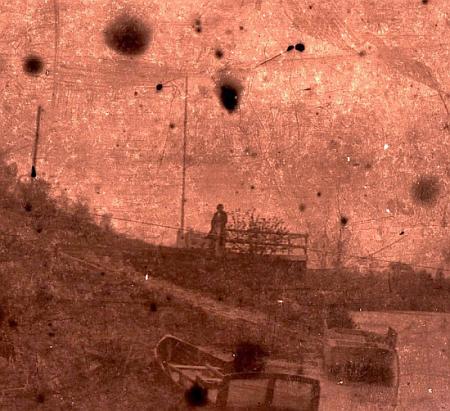
detail
glassplates ~ 1920
unknown photographer
flowerville
_______________________
Desert Islands [pdf]
Gilles Deleuze
translated by Michael Taormina
... everything that geography has told us about the two kinds of islands, the imagination knew already on its own and in another way. The élan that draws humans toward islands extends the double movement that produces islands in themselves. Dreaming of islands - whether with joy or in fear, it doesn't matter - is dreaming of pulling away, of being already separate, far from any continent, of being lost and alone - or it is dreaming of starting from scratch, recreating, beginning anew. (....) It is no longer the island that is separated from the continent, it is humans who find themselves separated from the world when on an island. It is no longer the island that is created from the bowels of the earth through the liquid depths, it is humans who create the world anew from the island and on the waters. Humans thus take up for themselves both movements of the island and are able to do so on an island that, precisely, lacks one kind of movement: humans can drift toward an island that is nonetheless originary, and they can create on an island that has merely drifted away. On closer inspection, we find here a new reason for every island to be and remain in theory deserted.
An island doesn't stop being deserted simply because it is inhabited. .... _______________________

The City
1919
Fernand Léger
1881-1955
Léger’s The City and neuroaesthetics
Anjan Chatterjee
Facing The City painted by Léger in 1919 can be an overwhelming experience. Geometry of bright colors, bits of human figures, mechanical structures, columns, stairs, lettering all crowd the painting and beyond into an immersive experience. The large canvas (7 feet 7 inches by 9 feet 9½ inches) is the focal point of the Philadelphia Museum of Art exhibit currently on view till 5 January 2014. The painting conveys the sense of being in the center of the cultural and intellectual maelstrom that was Paris after World War I. The exhibit places Léger’s art alongside the work of Delaunay-Turk, Mondrian, Duchamp, Picabia, van Doesburg, Le Corbusier, Ozenfant, Exter, and many others. Curiously, the painting also serves as metaphor for issues very much alive today in neuroaesthetics.
(....)
Finding coherence within crowded data is a struggle for every scientist. One’s focus is typically narrow, trained on the details of specific experiments. How to frame those experiments, the way in which results might generalize and help give the field coherence, is not always obvious in adolescent fields like neuroaesthetics. This lack of coherence is also what makes the field exciting. Anticipating the compositional structure of neuroaesthetics might reveal where fragments need to be added, modified, or even deleted. One tentative framework for neuroaesthetics is to consider aesthetic experiences within the triad of sensations/movements, emotions, and meaning. Empirical aesthetics has traditionally focused on sensations and their relation to emotions in a simple way. Do you like this object or not? We need much more.
For me, The City evokes excitement. The vibrant energy and pulse of the image conveys optimism and an open sense of possibilities. I adore cities and this painting taps into that adoration. However, the very same painting might alienate someone else. The reduced and fragmented forms could feel soulless and evoke the anomie of being another cog in an indifferent mechanical world. One of the most pressing areas of neuroaesthetics is to understand how knowledge and experience modulate our emotional responses to artworks.
...(more)
_______________________
Enslaved Ancestors, Technified Myths and the Summer of 2001
Wu Ming
(....)
At a certain point, a metaphor may suffer sclerosis and become less and less useful, until it’s void of all meaning, a disgusting cliché, an obstacle to the growth of inspiring stories. When this happens, people have to veer off, looking for other words and images.
Revolutionary and progressive movements have always found their own metaphors and narrated their myths. Most of the times these myths survived their being useful and became alienating. Rigor mortis set in, language became wooden, metaphors ended up enslaving the people instead of setting them free
[...]
No-one can erase mythological thought from human communication, because it’s embedded in the circuitry of our brains. As a matter of fact, every iconoclasm eventually generates a new iconophilia, against which new iconoclasts will rage. The cycle will be endless if we don’t understand the way these narratives work.
The trouble with myths is not their intrinsic falsehood, truth… or truthiness. The trouble with myths is that they sclerotise easily if we take them for granted. The flow of tales must be kept fresh and lively, we have to tell stories by ever changing means, angles and points of view, give our tales constant exercise so they don’t harden and darken and clog our brains.
...(more)
via Synthetic_zero
_______________________

Clowns Are Evil
accidental mysteries
_______________________
The science of consciousness must escape the religious dark ages
Michael S. A. Graziano
(....)
One of the more interesting, commonly overlooked properties of awareness is that we not only attribute it to ourselves, but we also attribute it to other people. When I’m in the room with another person, I have an immediate, gut intuition that the person is aware, aware of me, aware of the topic of conversation, aware of the other items in the room. I don’t need to figure it out cleverly. I don’t need to think it through. I can do that too, but prior to any higher order cognition, I have an immediate intuition, one might call it a social perception. My brain has attributed awareness to the other person much like it attributes the color blue to that person’s shirt. My brain attributes awareness and attaches a high degree of certainty to that attribution. Could it be that awareness is an attribution, and that the specific systems in the brain that compute it and project it onto other people are the same as the ones that attribute it to ourselves?
As long as the science of consciousness clings to the belief in magic, in an actual ethereal property of awareness somehow generated by the brain, then no progress is possible. Scientists who study consciousness need to look closely and see where their hidden spiritual assumptions lie.
...(more)
Consciousness and the Social Brain Michael Graziano google books
Colloquium: Consciousness and the Social Brain
How the light gets out
Michael Graziano
aeon
_______________________
Socialize Social Media!
A Manifesto
Benjamin Kunkel
n+1
Social media services can ultimately be run as public utilities, ad-free, at cost, in a democratic spirit and for social ends, in their enormous variety—or else digital society can become ever more subservient to the single end of the accumulation of private capital. The choice is between social life as an advertising platform and socialized social media. Tweeps and Facebook friends, unite! You have nothing to lose but some ads! (Except all the time you’re wasting. But you were already doing that.)
_______________________
Otto Dix works in Munich hoard speak truth to Hitler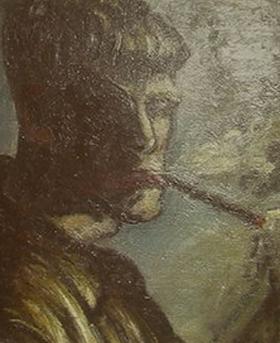
First glimpses of pictures by 'degenerate' modernist artist reflect grotesque carnival of lies and hypocrisies of German New Order
Jonathan Jones
(....)In his newly discovered self-portrait that was hidden from the world for so long, Dix sees himself as one of the sleazy sophisticates who inhabit his art. He looks like the slick city killer Mackie Messer in the song by his contemporaries Bertolt Brecht and Kurt Weill from their cynical masterpiece The Threepenny Opera.
Dix kills the lies people live by. He is one of the most subversive and satirical of modern artists, a visionary who recorded the chaos of German life on the eve of Nazism. He sees the world through a grotesque lens. His eye for people is precise yet extravagant. This wonderful painter took modernism as his licence to show his time and place the monstrous reflection of its crimes.
...(more)
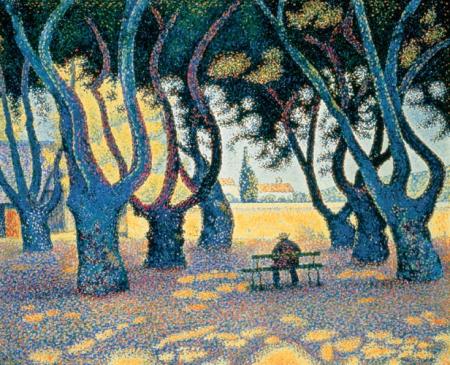
Plane Trees
Place des Lices, Saint-Tropez
1893
Paul Signac
b. November 11, 1863
_______________________
Answers
Elizabeth Jennings
(July 18, 1926 - October 26, 2001)
I keep my answers small and keep them near;
Big questions bruised my mind but still I let
Small answers be a bulwark to my fear.
The huge abstractions I keep from the light;
Small things I handled and caressed and loved.
I let the stars assume the whole of night.
But the big answers clamoured to be moved
Into my life. Their great audacity
Shouted to be acknowledged and believed.
Even when all small answers build up to
Protection of my spirit, I still hear
Big answers striving for their overthrow
And all the great conclusions coming near. thanks to flowerville
_______________________

Red Chimneys
Charles Demuth
_______________________
Economies of Affect/Affective Economies:
Towards A Spinozist Critique of Political Economy
Unemployed Negativity
(....)
Frédéric Lordon has argued that the point of intersection between Spinoza’s thought and Marx is not to be found in rereading superstition as ideology, or even in the isolated assertion of the affective dimension of money. Instead it is to be found in a more profound intersection between subjectivity and the economy. As Lordon argues Spinoza’s theory of the conatus, of the striving that defines each thing, is the connection point between a Spinozist ontology or anthropology, and a Marxist critique of political economy. This is not the connection argued for in some right wing appropriations of Spinoza, or left dismissals, which see in the conatus the assertion of self-interest that underlies all human actions. Spinoza’s striving is not the utility maximizing individual underlying contemporary economics. As Lordon argues, the conatus strives, but what it strives for, the objects it considers desirable and relations it pursues, are themselves determined by its capacity to be affected. This fundamental ontological and anthropological postulate has its corollary a social theory in which every mode of production must be considered as a particular problem of “colinearization,” a particular articulation of its striving with the striving of the individuals which comprise it.
(....)
The production of indignation is a difficult task, it goes against not just the perceived necessity of the capitalist mode of production but the ways in which our very desires, our most intimate strivings, have been produced by capitalism. From this perspective Spinoza’s central provocation to a critique of political economy is not the isolated remark about the power of money, but the fundamental thesis that men “believe themselves free because they are conscious of their own actions, and ignorant of the causes by which they are determined”. This assertion cuts against any assertion of the supposed desire for capitalism, the desire for consumer goods, etc., as its justification, such desires are merely effects taken as causes. Its destructive dimension, its pars destruens, is quite clear; what is less clear, however, is how it constitutes a positive political project. The starting point, beyond the difficult recognition of the way in which we are already determined, is Spinoza’s recognition that we endeavor to of those things that increase our joy, and shun those thoughts which weaken and sadden us. This affective tendency not only explains why we “fight for our servitude as if it was salvation,” but also why we continue, against all evidence to believe that the current economic system will eventually come around, reward us for our efforts. Moreover, not only must any radical transformation break the lines of articulation that weave together striving with labor, happiness with consumption, it must produce other joys, other ways to strive. A revolution is as much a reorientation of our affective relations as it is of social relations and cannot be one without the other.
...(more)
_______________________

Masts
1919
Charles Demuth
b. November 8, 1883
_______________________
Feedback
David Herd
Blackbox Manifold
#1
We are not done. After the April we had
And the August and the January, rain
Clean down against the dooryard steps,
Setting out the way the architecture
Separates things, places – persons,
Trees, bread – the way the documents
Stack up outwith the space set by
To read them, think how short time
Thou hast abyden here, airports
Certain outskirts of our cities, after
The process, the way the judgements
Foreclose; after the December and all
The elements left lying around us,
When the winds blow and the seas
Whose steadfast faith yet never moved,
Process, no change of rule only
The direction of governance, persons
Disregarded, after the borders
Closed; after the process, after
The wreckage in transmission, the rain,
The repetition, world without end,
In the streets we are not done,
This is unfinished business,
Outside standing, constructing space.
...(more)
_______________________
Family Affairs
Elizabeth Jennings
No longer here the blaze that we'd engender
Out of pure wrath. We pick at quarrels now
As fussy women stitch cotton, slow Now to forget and too far to surrender.
The anger stops, apologies also.
And in this end of summer, weighted calm
(Climate of mind, I mean), we are apart
Further than ever when we wished most harm.
Indifference lays a cold hand on the heart;
We need the violence to keep us warm.
Have we then learnt at last how to untie
The bonds of birth, umbilical long cord,
So that we live quite unconnected by
The blood we share? What monstrous kind of sword
Can sever veins and still we do not die?
_______________________

Parasol Pine
Paul Signac
_______________________
The Epic Art of the Haida Mythtellers
Matthew Spellberg on A Story as Sharp as a Knife : The Classical Haida Mythtellers and Their World
and
Being in Being : The Collected Works of a Master Haida Mythteller: Skaay of the Qquuna Qiighawaay and Nine Visits to the Mythworld
(....)
Bringhurst, a Canadian poet and translator, has spent the better part of a career studying the classical Haida literary tradition, and a decade translating thousands of lines of Haida myth-poetry into English. His trilogy consists of a book-length essay — A Story as Sharp as a Knife — on Haida literature, culture and ecology, and two volumes of poetry, each devoted to the corpus of a master Haida poet. These books, which deserve much greater recognition than they currently have, transmit the rich language of a long and once-flourishing poetic tradition:
After they’d travelled a ways,
A wren sang to one side of them.
They could see that it punctured
A blue hole in the heart
Of the one who passed closest to it, they say.
Something about the epic tone is unmistakable, even when the context of a given story has long ago been swallowed by history. The language is mingled vitality and violence; the stakes are high and the journeys are long; the characters are debased and distinguished. These qualities, more even than their fantastical elements, mark them as belonging to that archive of epic and myth which is the deepest foundation of nearly all literary traditions.
...(more)

Charles Corbet
Belgian autochromes
_______________________
The Jungle Line
Joni Mitchell
b. November 7, 1943
Rousseau walks on trumpet paths
Safaris to the heart of all that jazz
(....)
The jungle line, the jungle line
Screaming in a ritual of sound and time
Floating, drifting on the air-conditioned wind
And drooling for a taste of something smuggled in
Pretty women funneled through valves and smoke
Coy and bitchy, wild and fine
And charging elephants and chanting slaving boats
Charging, chanting down the jungle line
There's a poppy wreath on a soldier's tomb
There's a poppy snake in a dressing room
Poppy poison-poppy tourniquet
It slithers away on brass like mouthpiece spit
And metal skin and ivory birds
Go steaming up to Rousseau's vines
They go steaming up to Brooklyn Bridge
Steaming, steaming, steaming up the jungle line
_______________________
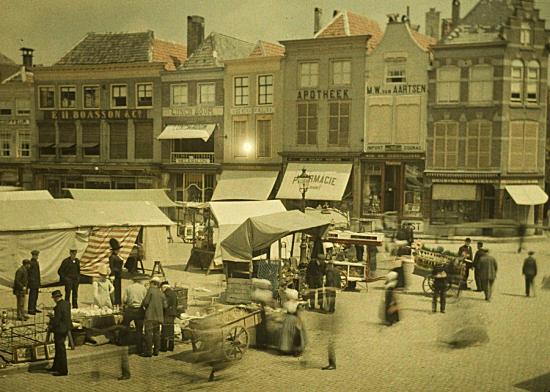
Marketday at Middelburg (NL)
c. 1910
Charles Corbet
_______________________
‘There is a Spectre Haunting . . .’:
Ghosts, Their Bodies, Some Philosophers, a Novel and the Cultural Politics of Climate Change
Nick Mansfield
bordlerlands
The ghost descends on us from the spirit-world, half pagan animus, half Christian soul, it threatens us with the meaning that exceeds us, or what exceeds meaning, the meaning that exceeds meaning, the unknowable, that which has crossed over to the other unknowable side, and then come back. It means something more than us and more than we can understand. Locked as we are in the bodily world, our horizons limited by the degradation of flesh, the spirit terrifies us with things we have forgotten, crimes we have forgotten or suppressed, but that the all-seeing eye of death has always registered, un-erasable, unforgettable and unforgiven, over there. … Apparently.
The ghost is offered to us but slightly with-held, available to us if only ever just that little bit out of reach, like death itself, for our bodies but not of them, slightly ahead of them, when they pass over to become, when they connect with, when in fact they release something else. Ghosts fascinated Marx, we are told by Derrida, the spectre that is haunting Europe in the opening words of The Communist manifesto, for example, but also in his favourite play Hamlet, a text governed by a ghost, a dead father tormented in Purgatory by penance for un-expunged sins, and calling on a lackadaisical self-indulgent son to for pity’s sake do something, kill someone, make a ghost or two of his own and then die. And ghosts fascinate Derrida too, two philosophers, one the most nagging and persistent thinker of the material; the other, the most adventurous thinker of the forever-beyond that is with us now, the Other, the difference within, the stranger in the house, the different in the same, the other in the self and so on forever without rest.
Yet, the orthodox idea of the ghost as that abstract thing that exceeds the bodily has not been uncontested. For Freud in ‘The uncanny,’ the spirit-world of the soul is not something alien to the body, but a double of it, an insistence on its continuity despite death. The spirit-world is not abstract, but a version of the material, a projection of our very physical bodies, our fantasy refusal of bodily mortality, and thus an assertion of our belief in our continued material being.
How does this questioning of the polarity between the abstraction and the materiality of the ghost help us with Marx and Derrida? What can we find out here about ghosts and their relationship to the bodily from the two philosophers who either wouldn’t care for the ideal as a key to the material, or who would mock the difference between them? I want to approach the question of the relationship between the body and the ghost through Derrida’s reading of Bataille’s reading of Marx’s own haunting father-figure Hegel, and then to turn briefly to Christos Tsiolkas’s novel Dead Europe, to argue that there is nothing as bodily as a ghost, ghosts are bodies, the body, and the one that is with us now, coming from the past but through the future to throw everything up for grabs, what Tom Cohen calls, not quite following Derrida again, and Derrida’s not quite following of Levinas, the wholly other. ...(more)
borderlandsnew forms of thought and writing in the humanities and social sciences. _______________________
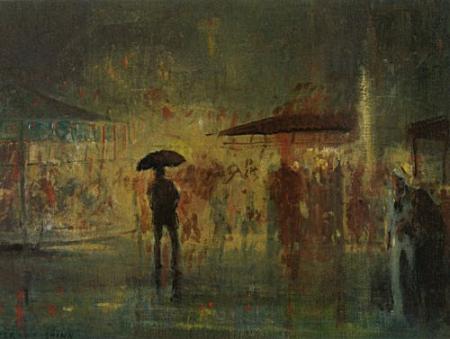
Everett Shinn
(November 6, 1876 – May 1, 1953)
_______________________
The Church says:
the body is a sin
Science says:
the body is a machine
Advertising says:
the body is a business
The body says:
I am a fiesta.
- Eduardo Galeano
_______________________
"On the poop deck of slave galleys it is possible, at any time and place, as we know, to sing the constellations while the convicts bend over the oars and exhaust themselves in the hold; it is always possible to record the social conversation that takes place on the benches of the amphitheater while the lion is crunching the victim. And it is very hard to make any objections to the art that has known such success in the past. But things have changed somewhat, and the number of convicts and martyrs has increased amazingly over the surface of the globe. In the face of so much suffering, if art insists on being a luxury, it will also be a lie."
- Albert Camus (b.Nov. 7, 1913), "Create Dangerously" in Resistance, Rebellian & Death
_______________________
If you want to have a compliant populace, what could be better than to say that everyone has to think positively and accept that anything that goes wrong in their lives is their own fault because they haven’t had a positive enough attitude? However, I don’t think that there is a central committee that sits there saying, “This is what we want to get people to believe.”
It took hold in the United States because in the ’80s and ’90s it became a business. You could write a book like Who Moved My Cheese?, which is a classic about accepting layoffs with a positive attitude. And then you could count on employers to buy them up and distribute them free to employees.
Barbara Ehrenreich interviewed
_______________________
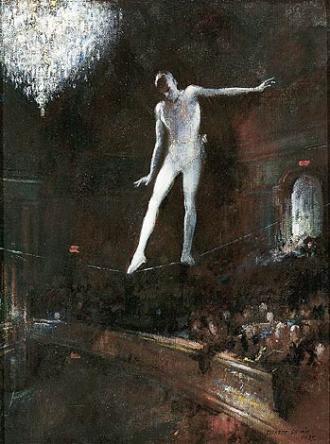 Everett Shinn
_______________________
"The Imminence of a Revelation Not Yet Produced":
Ashbery and the Pragmatist Sublime
Andrew Field
“Pragmatism,” James writes a paragraph later, “unstiffens all our theories, limbers them up and sets each one at work”. The same can be said, of course, for Ashbery’s poetry, and also for our experience, when we are more sensitized to it. Indeed, it is one of Ashbery’s greatest virtues as a writer that, in the way which Gunter Leypoldt describes Martha Nussbaum’s take on Henry James – “moral intelligence….understood as a heightened perception of complexity…[an] ethical progress [becoming] a question of improving our aesthetic powers of discrimination” – Ashbery augments our powers of feeling, perception and imagination, placing us more immediately within the variety of contexts which constitute our world. Ashbery, like both James brothers, makes our experience more powerful, more intense, more interesting, more enriching.
_______________________
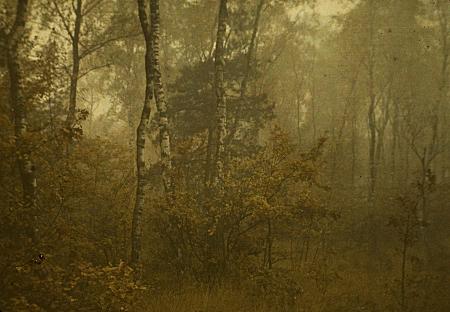
Misty wood
c. 1910
Charles Corbet
_______________________
I do believe that truth is better told in fiction. “People like stories” is the banal version of that. But there’s something deeper, when you really begin to press the question, and this does carry over from Faith of the Faithless, the idea of the supreme fiction or the politics of the supreme fiction. You think, “Well, what is not fiction?” If a fiction is something made, then what is not made up? All human activity is fiction. Even the fictions of science are fictions which are “verified,” but that’s a bag of worms when you begin to look at it. In a sense, our story is always some lie that we tell ourselves. It’s an obvious lie, it’s a fiction, the story we tell about our lives. Somehow, though, we can only get to the truth of things through someone else’s fiction. That’s the peculiar thing about human beings. It’s not that we need to have our own stories, or make up stories about ourselves, but somehow it’s only through stories about a character or a constellations of characters that the world becomes accessible to us.
Simon Critchley
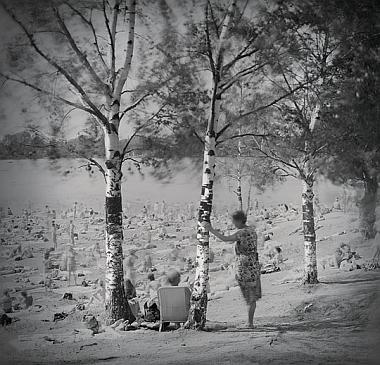
Time standing still
Alexey Titarenko
_______________________
“The poverty of our century is unlike that of any other. It is not, as poverty was before, the result of natural scarcity, but of a set of priorities imposed upon the rest of the world by the rich.”
John Berger
.....................................................
That have not been asked
ten dispatches about endurance in face of walls
John Berger
(....)
The poor have no residence. They have homes because they remember mothers or grandfathers or an aunt who brought them up. A residence is a fortress, not a story; it keeps the wild at bay. A residence needs walls. Nearly everyone among the poor dreams of a small residence, like dreaming of rest. However great the congestion, the poor live in the open, where they improvise, not residences, but places for themselves. These places are as much protagonists as their occupants; the places have their own lives to live and do not, like residences, wait on others. The poor live with the wind, with dampness, flying dust, silence, unbearable noise (sometimes with both; yes, that’s possible!) with ants, with large animals, with smells coming from the earth, rats, smoke, rain, vibrations from elsewhere, rumours, nightfall, and with each other. Between the inhabitants and these presences there are no clear marking lines. Inextricably confounded, they together make up the place’s life.
The poor are collectively unseizable. They are not only the majority on the planet, they are everywhere and the smallest event speaks of them. This is why the essential activity of the rich today is the building of walls – walls of concrete, of electronic surveillance, of missile barrages, minefields, frontier controls, and opaque media screens.
(....)
The secret of storytelling amongst the poor is the conviction that stories are told so that they may be listened to elsewhere, where somebody, or perhaps a legion of people, know better than the storyteller or the story’s protagonists, what life means. The powerful can’t tell stories: boasts are the opposite of stories, and any story however mild has to be fearless and the powerful today live nervously.
A story refers life to an alternative and more final judge who is far away. Maybe the judge is located in the future, or in the past that is still attentive, or maybe somewhere over the hill, where the day’s luck has changed (the poor have to refer often to bad or good luck) so that the last have become first.
Story-time (the time within a story) is not linear. The living and the dead meet as listeners and judges within this time, and the greater the number of listeners felt to be there, the more intimate the story becomes to each listener. Stories are one way of sharing the belief that justice is imminent. And for such a belief, children, women and men will fight at a given moment with astounding ferocity. This is why tyrants fear storytelling: all stories somehow refer to the story of their fall.
...(more)
.....................................................
“When we suffer anguish we return to early childhood because that is the period in which we first learnt to suffer the experience of total loss. It was more than that. It was the period in which we suffered more total losses than in all the rest of our life put together.”
John Berger

John Berger
b. November 5, 1926
Photograph by Flavia Costa, 2004
Ways of Seeing
John Berger
UbuWeb Film
Describe the truth until it sticks
John Berger
_______________________
Four Poems
Barry Dempster
Dares
The day dares me to pop
a few acorns in my mouth,
shut up for a minute and crunch.
I throw my arms around
the beefy oak, bark hard
with black muscle. A soft-
needled pine next time, smidgens
of cone darkening my hair.
I spend ages on my knees,
foraging the moss, searching
for a key dropped so long ago
it’s now a myth.
A thicket of horsetail prehistory.
Rose quartz poking its lichen-crowned
head into a blink of shooting sun.
Woodpecker hole the size of surprise.
When I step through the space
between Siamese poplars,
I leave the explained world behind.
An image of me balancing
on two shaky stones,
veering like a dragonfly
as if I’ve just caught on
gravity is more than standing up.
How unmasked it feels
to be rocked. I lean so far to the right
a stumble loosens my ankles,
a squirrel leaps, an uneaten acorn
shivers on its stem like a bell.
...(more)
Canadian Poetries
_______________________

photo - mw
_______________________
Commute
Sebastian Agudelo
i.
On the platform, blood and wing bones
like leftovers from some Obeah jinx.
A kid’s tutu on the tracks.
On the air, urine and cold cream,
overheard talk the train drowns
as it lumbers in, whines, and bangs open.
In, to where Virginia Woolf confined
her progeny, the novelists in the future,
omnibuses and underground railways.
Via Crucisor way of virtue, she won’t say
nor venture what flash fictions or elliptic
avants will birth, hallows on instead
these the depths they will explore,
those the phantoms they’ll pursue.
Superimposed, shallow with detail
punctuated by the intermittent fade out
as the tunnel lights strobe in, bleached
by station lights, poor contorted devils sit,
the penitent stand and hold on,
souls ferried, back and forth,
to the mild prosaic hells of shifts.
...(more)
At Length
_______________________
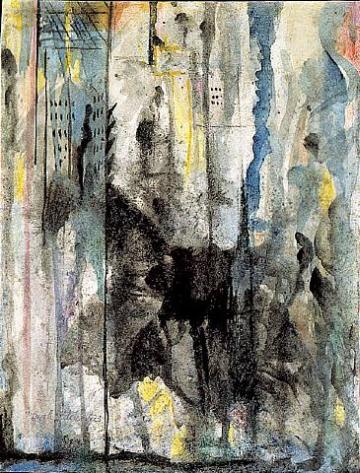
NY Interpreted-The Bridge Study
Joseph Stella
d. November 5, 1946
_______________________
November Night
Adelaide Crapsey
Listen.
With faint dry sound,
Like steps of passing ghosts,
The leaves, frost-crisp’d, break from the trees
And fall.
via Patrick Kurp
Anecdotal Evidence
.....................................................
NIGHT WINDS
Adelaide Crapsey
The old
Old winds that blew
When chaos was, what do
They tell the clattered trees that I
Should weep?
28 cinquains from Adelaide Crapsey's Verse
The complete works of Adelaide Crapsey
Cinquain.org
- A scholarly exploration of the American cinquain as popularized by Adelaide Crapsey
Adelaide Crapsey
(1878-1914
_______________________
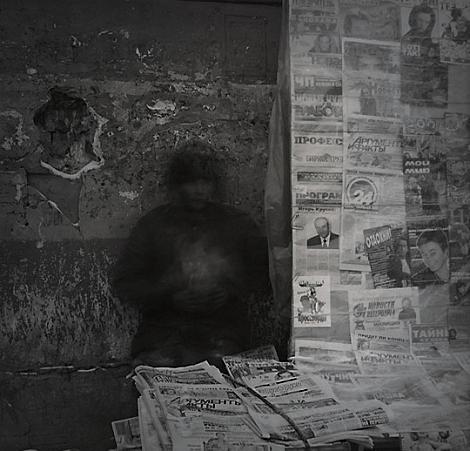
Alexey Titarenko
_______________________
“Common-sense is part of the home-made ideology of those who have been deprived of fundamental learning, of those who have been kept ignorant. This ideology is compounded from different sources: items that have survived from religion, items of empirical knowledge, items of protective skepticism, items culled for comfort from the superficial learning that is supplied. But the point is that common-sense can never teach itself, can never advance beyond its own limits, for as soon as the lack of fundamental learning has been made good, all items become questionable and the whole function of common-sense is destroyed. Common-sense can only exist as a category insofar as it can be distinguished from the spirit of inquiry, from philosophy.”
John Berger
John Berger´s Quotations
_______________________
Books Are
Barry Dempster
From: Letters from a Long Illness with the World, the D.H. Lawrence Poems. London, Ontario : Brick Books, 1993
Books do not breathe, or
share your soup, stroke your
arms, inhale your rare perfumes.
Books do not spit, love or scheme
for more. Books do not live
parallel lives. Books do not
pray or hold mirrors unto God.
Books do not die with regrets.
...(more)
Barry Dempster
12 or 20 questions: with Barry Dempster
_______________________

photo - mw
_______________________
Textual Communities: Nancy, Blanchot, Derrida
Kuisma Korhonen
(....)
III
Is there still any form of community that would not lead us to the kind of 'identity rage' that created the Holocaust and the Gulag? That would still count as a 'community' and resist the war of everyone against everyone that governs the logic of neo-capitalism? Can we form a community, for example a community of readers, which would not identify itself as antagonistic to other communities?
These are some of the questions that have given rise to the contemporary debate on the notion of community. Although the roots of this debate are deeply embedded in the Western philosophical tradition, we can discern the starting point for a more recent discussion in Jean-Luc Nancy's essay 'La communauté desoeuvré' (1983), in which the French philosopher borrowed the central notion of désouvrement from Maurice Blanchot while reading the work of Georges Bataille. Blanchot soon replied to Nancy in a small book called La communauté inavouable (1983), which included two essays, 'La communauté negative', on Nancy's close reading of Bataille and 'La communauté des amants', on a récit by Marguerite Duras. The foundational figure in this dialogue was, in a way, Bataille, but we know that Bataille was already deeply influenced by Blanchot; and even though Blanchot seemed to be just commenting upon Nancy's text, we also know that Nancy's text had been already heavily influenced by Blanchot. Nancy then continued the dialogue in two books: La communauté desoeuvré (1986) and La communauté affrontée (2001). This dialogue is thus already a work of a textual community ' a virtual, heterogeneous, changing, and temporary community that also includes thinkers such as Emmanuel Levinas, Jacques Derrida, Giorgio Agamben and Alphonso Lingis.
In the background of this discussion has been the conviction, shared more or less by all the authors mentioned above but expressed perhaps most memorably by Levinas, that human subjects come into being only in relation to the Other. Singularities may gain their subjectivity only by facing the other or the multiplicity of others; before one can construct any immanent self-hood, one has already been called into question by the existence of others.
Some primal community is thus inescapable, but it is soon replaced by communities that constitute themselves as work ' communities that exist in order to produce an identifiable institution that then defines the identity of its members, or communities that are produced by the work of those institutions. ...(more)
Community
Edited by Dorota Glowacka Culture Machine, Vol 8 (2006)

Lossiemouth II, Moray, Scotland 2011
The Last Stand
Marc Wilson
via junk for code
_______________________
Gródek
Georg Trakl
d. Nov. 3, 1914
Translated by James Wright and Robert Bly
At evening the woods of autumn are full of the sound
Of the weapons of death, golden fields
And blue lakes, over which the darkening sun
Rolls down; night gathers in
Dying recruits, the animal cries
Of their burst mouths.
Yet a red cloud , in which a furious god,
The spilled blood itself, has its home, silently
Gathers, a moonlike coolness in the willow bottoms;
All the roads spread out into the black mold.
Under the gold branches of the night and stars
The sister’s shadow falters through the diminishing grove,
To greet the ghosts of the heroes, bleeding heads;
And from the reeds the sound of the dark flutes of autumn rises.
O prouder grief ! you bronze altars,
The hot flame of the spirit is fed today by a more monstrous pain,
The unborn grandchildren.
Twenty Poems of Georg Trakl [pdf]
Translated and Chosen James Wright and Robert Bly
Index of all literary texts of Georg Trakltranslations by Jim Doss and Werner Schmitt
Wersch's Trakl-Site _______________________
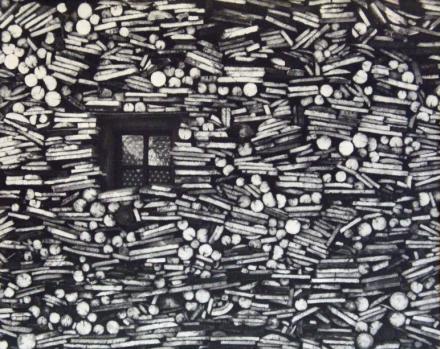
Martin Martinček
1913 - 2004
_______________________
Dante's Sublime Comedy: Purgatory, Chapter 5
More Not-Yet-Purified
Alasdair Gray
I left these ghosts to follow him uphill,
then heard behind new voices shouting, “See –
sunlight can’t pierce him, so he is not dead!”
3
Turning my head I saw an eager crowd
staring upon my shadow, also me.
“Don’t let words turn you. Face the uphill track,”
6
my leader cried. “Good heads should imitate
those tower-tops unshook by windy blast.
Ignore what people say. Distracted minds
9
go easily astray because each thought
cancels the last.” “Coming!” I called (for what
else could I say?) and hurried after him,
12
...(more)
_______________________
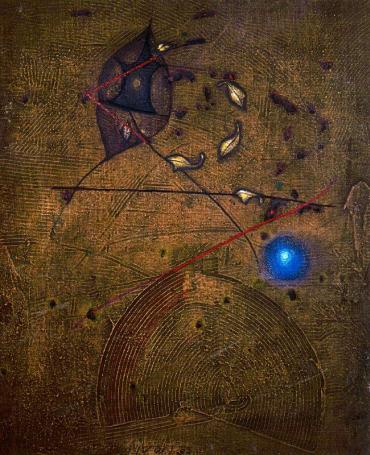 Mixed media
Modest Cuixart
b. November 2, 1925
_______________________
Kafka: The Years of Insight, by Reiner Stach
reviewed by Steve Mitchlemore
this space
(....)
... Over the decades there have been innumerable readings of Kafka's fiction named under various scholarly disciplines, each one underwriting his stories with a theoretical rigour lacking in everyday communication. This guarantees at least three things: that Kafka's fiction can be contained by structured analysis, has value only insofar as it confirms the premises of that analysis, and that the stories are capacious enough to accommodate an infinite number of disciplines. The first and second are full of promise for the reader keen to learn and use fiction as proof of theoretical authority. They also nullify the superstitious power of the object while allowing it to live like an insect quivering in a spider's web. However, these guarantees are possible only insofar as one is able to deal with the inherent bad faith of the third: why choose the Freudian reading over the Marxist? Or, if you think the Existentialist reading fails, what do you think of Gnostic one? In bringing social esteem to the daydream of fiction, analysis raises fiction to new heights or depths of impenetrability, leaving the third guarantee full of despair because the number and variety of readings demands a decision, sending the reader back to the beginning of the search, only this time in the shadow of an entire library. Who is quivering now?
Biography offers a compromise in that it is a craft requiring certain constraints yet without the rigidity of a theoretical armature: it is both authoritative and curious. ...(more)
_______________________

Henry Heerup
b. November 4, 1907
_______________________
Harper's Seven-Year War on Science
Crawford Kilian
the tyee
Chris Turner's The War on Science: Muzzled Scientists and Wilful Blindness in Stephen Harper's Canada is a solidly researched, well-written book that had to be published. But the people who should read it are not interested in what it tells them about themselves.
If anything has marked the seven years of Conservative rule, it's been the Tories' willingness to repudiate not just previous Liberal and Progressive Conservative governments, but the whole of history since the 18th-century Enlightenment. They're a political vindication of Newton: for every action, there's an equal and opposite reaction.
In this case, the reactionaries are carrying us back to sometime around 1513, before ideas like reason and empirical research became the basis for understanding the world. Like counterparts around the world -- the Tea Party in the U.S., for one -- they are happy to use the products of science to promote their deeply anti-science beliefs ...(more)
_______________________
Politics and the Canadian Language
Crawford Kilian
TheTyee
(....)
The debasement of political language is nothing new. George Orwell's 1946 essay "Politics and the English Language" described the decline of British political discourse in the 1930s and '40s.
But Orwell's thoughts are still current: English, he said, "becomes ugly and inaccurate because our thoughts are foolish, but the slovenliness of our language makes it easier for us to have foolish thoughts."
"Orthodoxy, of whatever colour," he added, "seems to demand a lifeless, imitative style" -- a lesson taken to heart by compilers of Conservative talking points, as well as his note that "in our time, political speech and writing are largely the defence of the indefensible."
Canadians can make a modest claim to carrying on that debasement -- taking the worst outrages from other English-speaking nations and adding distinctive adulterants of maple syrup, Timbits, and bitumen to the once-eloquent political English of Tom Paine, Edmund Burke, and John Locke.
...(more)
_______________________
"Freedom of Assembly, or Who are "the People"?"
Judith Butler
lecture for The Center for the Study of Social Difference
video at -synthetic_zero
_______________________

Copernicus Modest Cuixart
_______________________
Mark Weiss: “Glass Palace,” 17 Poems
presented by Jerome Rothenberg
(....)
Ease Of Motion
This fantasy that has deluded many,
that you could open the door and walk
into another place,
just like that.
(....)
Exile
The pace of change being what it is
the homeland you dreamed of
is no longer there.
Like Troy to the Trojans, no stone
left as a marker.
...(more)
A note in the place of a poetics.
Put two things next to each other and a third thing happens. Sometimes a series of short poems create their own world, but fragmented, like reflections on shards of glass. (M.W.)
_______________________
Words without Borders November 2013
Celebrating Our First Ten Years
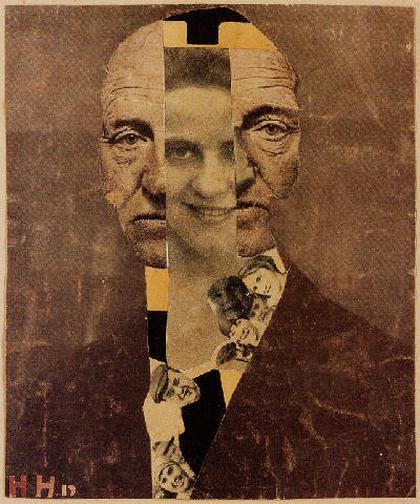
Hannah Höch
b. November 1, 1889
_______________________
Sea Surface Full Of Clouds
Wallace Stevens
I
In that November off Tehuantepec,
The slopping of the sea grew still one night
And in the morning summer hued the deck
And made one think of rosy chocolate
And gilt umbrellas. Paradisal green
Gave suavity to the perplexed machine
Of ocean, which like limpid water lay.
Who, then, in that ambrosial latitude
Out of the light evolved the morning blooms,
Who, then, evolved the sea-blooms from the clouds
Diffusing balm in that Pacific calm?
C’était mon enfant, mon bijou, mon âme.
The sea-clouds whitened far below the calm
And moved, as blooms move, in the swimming green
And in its watery radiance, while the hue
Of heaven in an antique reflection rolled
Round those flotillas. And sometimes the sea
Poured brilliant iris on the glistening blue.
...(more)
_______________________
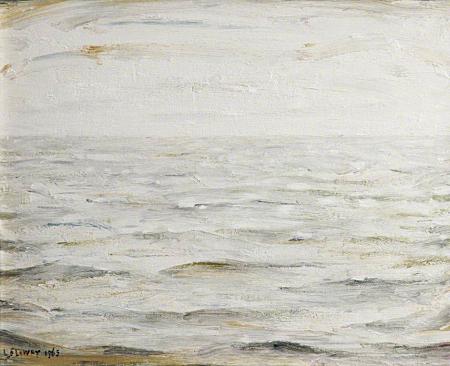
The Sea at Sunderland
c 1965
Laurence S. Lowry
b. November 1, 1887
_______________________
The Kafkaesque World of Data Mining
Gilbert Mercier
In the surreal world we live in, reality has become stranger than fiction. The information super highway could have produced a completely transparent world, yet the elusive corporate and governmental nexus of Big Brothers has surrounded itself with layers of opacity, secrecy and deception. Meanwhile, ordinary citizens are probed, exposed and have become open books to organizations such as the United States National Security Agency (NSA) and corporations that run search engines and social media. In one case, it is done in the name of security and prevention of terrorist attacks, in the other it is done in the name of commerce. Factual and fictional have become so blurred that many dreams have a more logical structure than current events. It is as if reality is trapped, like a fly in a spider web, in the matrix of a nightmarish and grotesque virtual construct. Perhaps the best way to understand this layered reality — both hyper-connected and paradoxically disconnected — is to look into fiction, especially the work of Franz Kafka.
...(more)
_______________________
Dr. Panopticon, or, How I Learned to Stop Worrying and Love the Drone
Caren Myers Morrison
Abstract:
Of all the ways the government has to watch us, unmanned aerial vehicles, commonly known as drones, best capture the visceral fear of the all-seeing surveillance state. Because drones are becoming increasingly tiny, inexpensive, and powerful, they could enable a new species of universal surveillance, turning our cities into a modern version of Bentham’s panopticon. But this essay, written for the criminal justice symposium issue of the JCRED, is not about the alarming consequences of surveillance technology. Instead, it seeks to explore whether there is anything useful to be learned from the possibility of continuous mass surveillance. Not just useful in terms of solving crime or combating terrorism, but rather in reassessing the balance of power between the state and the people.
The system we have now — which privileges the right to privacy inside the home over the right to be secure against coercive police-citizen encounters — places the burden of police intrusion disproportionately on the poor and on minorities. While there are many good arguments that can be made in defense of privacy, they cannot be fairly assessed when state power is implemented in such an unbalanced way. So what I am suggesting is a thought experiment: Let us imagine that the government could use drones to monitor our every move out of doors. If it were found to be cost-effective and productive, could drone surveillance supplant profiling and other police practices that make members of specific communities feel singled out and humiliated? Might this actually be preferable?
I am not seriously proposing that we should all stop worrying and love the drone. But maybe this kind of faceless, technological surveillance could be implemented in a way that might be less error-prone, less arbitrary and discriminatory than what we have now. If nothing else, drones allow us to imagine a more egalitarian system of government information-gathering, one that does not fall so disproportionately and so hard on the millions who never really had any privacy in the first place.
_______________________
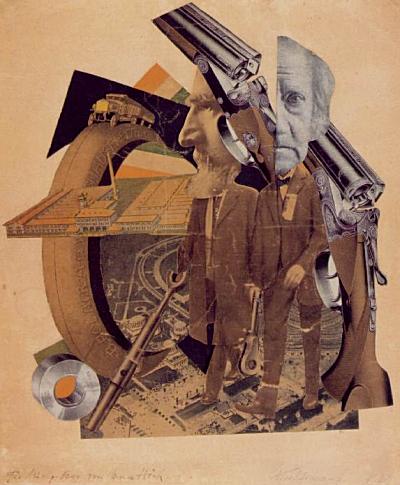
High Finance
Hannah Höch
1923
_______________________
The NGO sector: The Trojan horse of capitalism
Crn Blok
libcom
There is very little theory out there about the issue of the NGO sector and the way it affects the social struggle. This is a translated version of a pamphlet written by "Crn Blok" - an anarchist group from Macedonia, where all dissent is being suffocated by a large number of various NGOs and their army of full-time professional "freedom fighters".
There is a good reason why we, anarchists, would pay some attention to the Non-Governmental Organisation (NGO) sector, principally because the general public considers this "third sector" as a tool for democratisation of society, and even worse, as an alternative to the struggle against centralized authority, oppression, poverty and all the other collective misfortunes of the people. To us, this is yet another of the great deceptions of capitalism that serve to keep the illusion of choice and freedom alive. That thing about the elections - that they'd be illegal if they could really change anything - applies to the NGO sector as well, which, beside being tolerated and even encouraged by every government, is still believed to be a mechanism for struggle against the injustice, an antipode of the government and a platform for participation in the political discourse.
In opposition, we believe it has a very different role: to become a mediator between the government and the people, thus suppressing people's anger; to convert the potential uncontrollable dissent into a calm, peaceful, legal, controlled, institutionalized and completely harmless discontent; to support capitalism, by creating a good image for the corporations and by propagating the ruling ideology; and finally, to create an illusion of struggling for a change.
...(more)
_______________________

Hannah Höch
_______________________
W. G. Sebald (Stray Notes)
John Latta
W. G. Sebald, out of the “Foreword” to A Place in the Country (2013):
There seems to be no remedy to the vice of literature; those afflicted persist in the habit despite the fact that there is no longer any pleasure to be derived from it, even at that critical age when . . . one every day runs the risk of becoming simpleminded, and longs for nothing more than to put a halt to the wheels ceaselessly turning in one’s head . . .
Sebald’s root uneasiness with writing, its tendency towards an unthwartable graphomania. Recall the squib out of Sebald’s Unrecounted (2004): “This writing paper // smells / like wood shavings / inside the coffin.”
—
Or the lines out of The Rings of Saturn (1998):
Everything is on the point of decline, and only the weeds flourish: bindweed strangles the shrubs, the yellow roots of nettles creep onward in the soil, burdock stands a whole head taller than oneself, brown rot and greenfly are everywhere, and even the sheets of paper on which one endeavours to put together a few words and a sentence seem covered in mildew. For days and weeks on end one racks one’s brains to no avail, and, if asked, one could not say whether one goes on writing purely out of habit, or a craving for admiration, or because one knows not how to do anything other, or out of sheer wonderment, despair or outrage, any more than one could say whether writing renders one more perceptive or more insane. ...(more)
_______________________
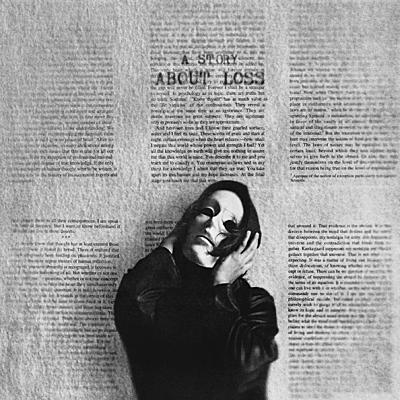
conceptual
Thymournia
via (OvO)
_______________________
Wallace Stevens in the World
Robert Hass
(....)Years later though, when I looked at “The Emperor of Ice-Cream” again, I felt much more forgiving of the tone of the poem. I said to myself, this isn’t Babbitt fantasying himself a houseful of servants in Hartford, it is Prospero speaking to his daughter, and speaking in the subjunctive at that. But saying this, one also had to say that in Shakespeare and throughout English literature, royalty expressed as power over others is a central figure for the power of imagination. And somewhere in those years it occurred to me finally that the poem is about death, which I thought made it a more wonderful and darker joke than I had understood. And at some still later stage, I think it must have been after reading Helen Vendler on the use of the subjunctive in Stevens, but also after I had had enough experience of failure and disappointment in my own life to get it, I felt the pathos of the wishing in the poem and of the grammar that expresses that pathos, so that by the time I was the age of Stevens when he wrote the poem, the three words “let be be . . .” struck me as a brilliant and sad figure for the fundamental human wish that seems so often impossible for us and that Stevens had taken for one of his central themes.
...(more)
_______________________
Otoliths 31
edited by Mark Young
|




































